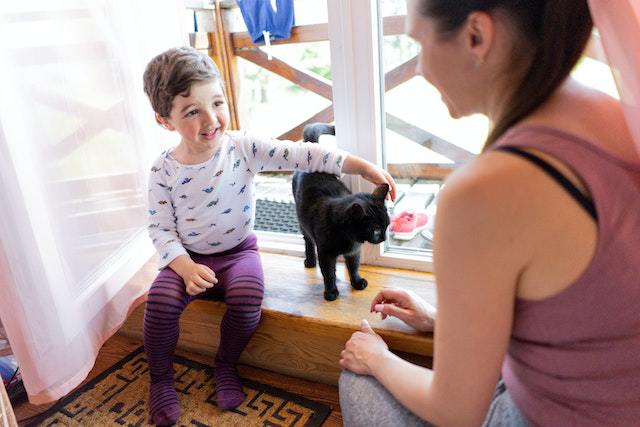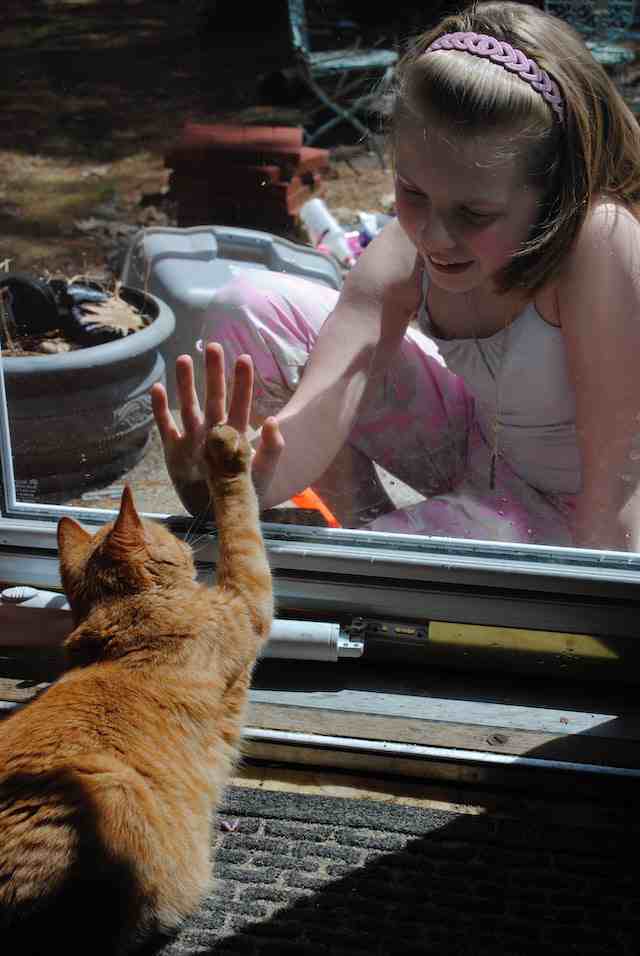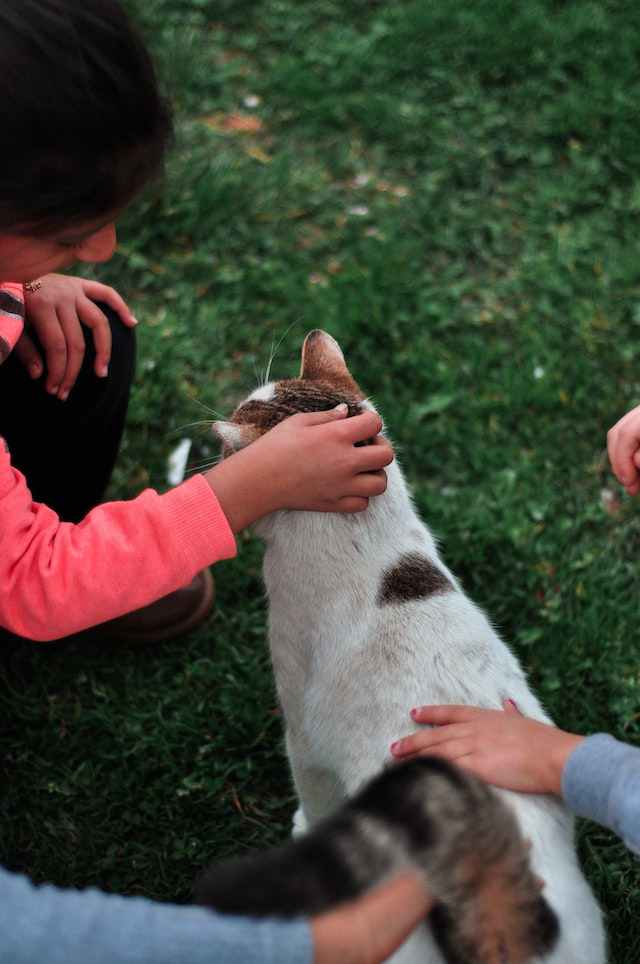10 Most Useful Cat Socialization Tips

Cats are often stereotyped as aloof creatures that prefer hanging out by themselves rather than socializing with others. However, this couldn’t be further from the truth!
As cat owners and enthusiasts know, these furry felines are social beings that crave interaction, playtime, and companionship.
In this brief blog post, we’ll explore the ins and outs of cat socialization, including tips and tricks for helping your kitty develop healthy social skills and form strong bonds with both humans and other cats.
So, whether you’re a seasoned cat owner or considering adopting a new feline friend, read on to learn everything you need to know about cat socialization.
What is Cat Socialization
Cat socialization refers to the process of gradually exposing a cat to various living beings and situations, such as humans, other cats, and new environments, in order to acclimate it and help it become more comfortable and well-adjusted to social situations.
Socializing a cat can help prevent fear, aggression, and timidness, and make it more likely to develop affectionate and trusting relationships with its human family.
The process of cat socialization typically involves introducing the cat to new experiences gradually and using positive reinforcement to reward good behavior.
Learn more about how abandoned cats behave.
Benefits of Cat Socialization

Here are some of the most common benefits of cat socialization:
- Improved social skills: Socialization helps kittens develop social skills, which makes it easier for them to interact with other cats and humans throughout their lifetime.
- Reduced stress: Well-socialized cats are less likely to become stressed or anxious in unfamiliar situations or around new people or animals.
- Increased confidence: Socialization builds a cat’s confidence and helps them become more comfortable in new situations.
- Better behavior: Socialized cats are more likely to exhibit good behavior and be well-behaved around other cats and humans.
- Easier vet visits: Cat socialization can make vet visits less stressful for both cats and their owners, as well as make it easier for vets to do their job.
- Stronger bonds: Cats that are well-socialized are more likely to form strong bonds with their owners and other cats in the household.
- Increased activity: Socialized cats are generally more active and engaged with their surroundings, which helps keep them physically and mentally healthy.
- Improved adoption chances: Cats that are well-socialized are more likely to be adopted from shelters or rescue organizations, as they tend to be more friendly and sociable with humans.
- Reduced risk of aggression: Early socialization can reduce the risk of a cat becoming aggressive towards other cats or humans, which can improve their quality of life and safety.
It’s worth noting that socialization is most effective during the first few weeks of a kitten’s life, but older cats can still benefit from socialization activities and training.
Learn more about behavior problems in cats and solutions.

The main socialization window for kittens is from 2 to 7 weeks of age, but it can extend up to 14 weeks. During this time, cats are most receptive to new experiences and relationships.
After this period, socialization can still occur, but it may be more challenging, therefore, it is best to start socializing kittens between 2 and 7 weeks of age.
Common Ways of Cat Socialization

The following are some common ways of cat socialization:
1. Taking your cat for an evening walk
Taking your cat for an evening walk on a leash is one of the popular ways of socializing your cat. While most people associate walks on a leash with dogs, cats can also benefit from the outdoor experience. Not only does it provide your cat with the opportunity to explore outside, but it also helps them to get exercise, which is essential for their health and well-being.
Walking your cat on a leash can also help in building a strong bond with your pet. By exposing them to different sounds, textures, and smells, you are providing them with a stimulating environment, which helps in reducing their stress level and boost their cognitive function.
However, it’s important to note that not all cats are suitable for walks on a leash. Some cats may find it too stressful or scary, and may not be interested in exploring outside. Therefore, it’s essential to start with short walks and observe your cat’s behavior to determine if walking on a leash is an activity they enjoy.
Also, ensure that you use a harness instead of a collar to prevent your cat from choking. With patience and proper training, taking your cat for walks on a leash can be a fun and engaging way to socialize them.
Learn more about important cat care tips you should know.
To provide your feline friend with social interaction, plan playdates with other amiable and well-mannered cats. Start with brief, closely supervised sessions in a neutral setting, such as a sizable room.
Make certain that each cat has adequate space to hide if necessary. To maintain a happy and stimulating environment, give out toys and snacks. Keep a watchful eye on their interactions and search for cues that either cat is at ease or having fun.
Separate the cats and try again later if any signs of aggressiveness or discomfort appear. Positive playdates can improve your cat’s social abilities and enhance their quality of life.
3. Set up car rides and travel training
Many cats associate unpleasant situations with automobile trips, usually ones connected to trips to the vet. Slowly acclimate your cat to car journeys to combat this bad association.
Start by letting them investigate an abandoned car whose doors are open. To establish a favorable relationship, put food or their favorite blanket inside. Move on to short drives around the block with a safe carrier once they are comfortable doing this.
During and after each trip, give out rewards and compliments to promote positive experiences. This methodical strategy makes future trips less unpleasant for your cat and helps increase its confidence.
4. Introduction of your cat to various sounds and smells
By exposing your cat to a variety of sounds and smells, you can lessen their sensitivity to loud noises and help them adapt to new settings. While you’re with them, put on some relaxing background music or nature noises.
Start with a low volume and gradually raise it to gradually introduce recordings of commonplace sounds like vacuum cleaners or doorbells.
This exposure helps your cat become resilient and at ease in a variety of environments. To further foster a tranquil environment, think about utilizing pet-friendly fragrances or pheromone sprays.
Learn more about smells cats dislike.
5. Encouraging exposure of cats to different people

It’s important for your cat to be exposed to a range of individuals as part of their socialization. Introduce them to your personal family first, and then gradually introduce them to your friends and guests.
Start with quick introductions in a serene and quiet setting. Your cat should be allowed to interact with strangers at their own speed.
If your cat shows interest, invite guests to play or offer treats. Your cat will gradually gain confidence among diverse people, which can lessen social anxiety.
6. Introduction of the cat to other pets
If you already have pets in your home, you should take special care when introducing your new cat to them. To get the animals acquainted with one another’s scent, start by using scent-exchanging procedures.
Exchange toys or bedding with the animals to encourage exploration and acclimatization to one another’s scents. Using this method can lessen the nervousness associated with face-to-face introductions.
Gradually go toward supervised encounters in a regulated setting. To encourage positive interactions, treat or praise good behavior. Always exercise patience because different cats require different amounts of time to successfully integrate.
7. Engaging your cat in interactive play sessions
Playing interactively with your cat is a great method to socialize them. Set aside time each day for concentrated play, utilizing interactive puzzle toys, feather toys, or other toys that appeal to children’s natural impulses.
To keep your cat interested, create movement and emulate prey-like behavior. This not only gives you and your cat cerebral and physical stimulation, but it also deepens your relationship with them.
Playtime sessions are crucial for their general well-being and can help release any tension or unreleased energy.
8. Regular gentle handling and touching of your cat

Cat socialization requires developing trust through gentle handling and touch. Start by settling down or kneeling close to your cat in their secure location.
Give them a gentle touch and invite them to you. Start by using a light touch and steady, calm strokes on their back. Pay attention to how they’re acting and respect their personal space.
Give them some room and try again later if they start to withdraw or exhibit signs of discomfort. Your cat will eventually learn to correlate touch with pleasant memories and grow accustomed to human contact.
9. Gradual introduction of your cat to new environments
It’s important to give a new cat time to adjust when bringing them into your home. Start by limiting them to a small, secure area, such as a bathroom or spare room.
Provide the area with necessities like food, water, a litter box, a cozy bed, and a few toys. Your cat can feel safe in this special area because it serves as a sanctuary.
One room at a time, gradually introduce children to other regions of your house. They are less likely to feel overwhelmed thanks to this progressive approach, which also gives them a sense of control while they explore their new surroundings.
For supervised locations where your cat can socialize with other cats and people, cat cafes and socialization programs are fantastic possibilities. Do your homework and pick reputable cat cafes or socialization sessions that put the welfare and security of the cats first.
Make sure the area is pristine, well-kept, and staffed by knowledgeable individuals.
Allowing them to explore at their own pace, gradually acclimate your cat to the new surroundings.
Monitor their interactions with other cats and encourage them with praise when they are being sociable and composed. To develop familiarity and comfort, gradually lengthen visits and increase their frequency.

Here are some ways to identify a well-socialized cat:
- Seeks affection from humans: One of the signs of a well-socialized cat is that it seeks affection from humans and enjoys being around them.
- Comfortable with other cats and pets: A well-socialized cat should also be comfortable around other cats and pets and not display any aggressive behavior towards them.
- Enjoys being touched: A well-socialized cat should also be comfortable with being touched and handled by humans. They should not become aggressive or anxious when they are picked up or petted.
- Confident and curious: A well-socialized cat should exhibit confidence and curiosity in new situations and environments. They should be willing to explore their surroundings and interact with new people and animals.
- Displays relaxed body language: A cat that is well-socialized will generally display relaxed body language, such as a calm and loose posture and a softly curled tail. They may also purr, knead, or vocalize in response to human interaction.
Related Questions
What if my cat is afraid of new people or situations?
If your cat is afraid of new people, thunderstorms, or situations, it’s important to take things slowly and avoid overwhelming them. Gradual exposure and positive reinforcement can help them become more comfortable over time. If your cat is particularly fearful or anxious, you may want to consult with a veterinarian or animal behaviorist for additional guidance.
While socialization and training are not the same thing, they are closely connected. Socialization helps your cat learn how to interact appropriately with other animals and humans, while training focuses on teaching specific behaviors or commands. Both socialization and training can contribute to a well-behaved and happy cat.
The socialization process can vary depending on your cat’s temperament, age, and previous experiences. While some cats may become socialized relatively quickly, others may require more time and patience. It’s important to allow your cat to progress at their own pace and avoid rushing the process. With time and dedication, however, most cats can become well-socialized and confident in a variety of situations.
Signs of stress in cats can include hiding, excessive grooming, excessive meowing or vocalization, aggressive behavior, and avoiding interaction with people or other animals. If you notice any of these signs, it’s important to give your cat plenty of space and time to adjust to their surroundings, and to seek the advice of a veterinarian or behaviorist if needed.
While socializing kittens is generally easier and more effective, adult cats can still be socialized with patience, persistence, and positive reinforcement. It may take longer for an adult cat to adjust to a new environment or other animals, but with consistent and gentle socialization, it’s possible for them to become more comfortable and relaxed.
It’s generally not a good idea to let your cat outside during the socialization process, as this can be overwhelming and overstimulating for most cats. It’s best to keep your cat indoors until they are fully socialized and comfortable in their surroundings.
Some ways to make the socialization process more enjoyable for your cat include providing plenty of toys, treats, and comfortable hiding spots, as well as positive reinforcement in the form of praise and rewards. It’s also important to be patient and gentle with your cat and to give them plenty of space and time to adjust to their surroundings.
Conclusion
In conclusion, socializing your furry feline friend is an essential component of responsible pet ownership.
Whether your kitty is a young kitten or an adult cat, exposing them to new experiences and people can help reduce anxiety, improve behavior, and overall enhance their quality of life.
Remember, socialization or training takes time and patience, but the effort you put in will undoubtedly pay off in the form of a happy, well-adjusted cat who loves spending time with their favorite humans. So don’t hesitate to start socializing your feline today!
